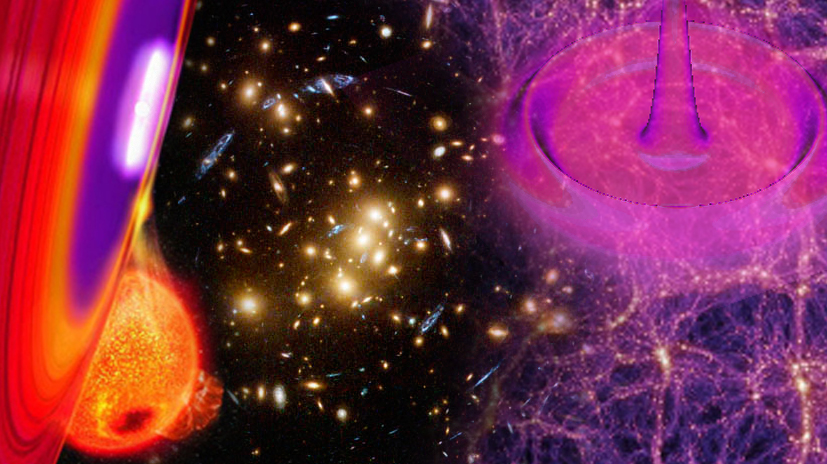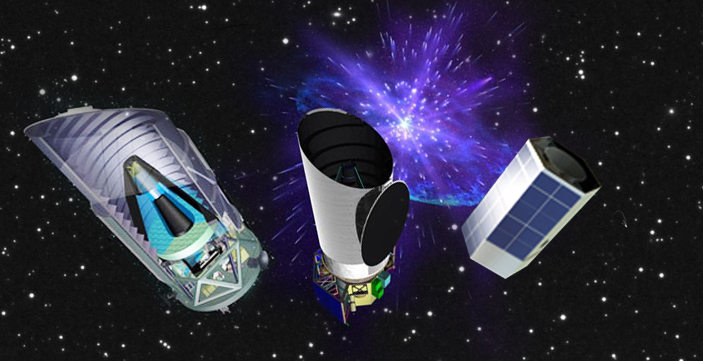Contact: Paul Preuss, (510) 486-6249
On November 19 the U.S. Department of Energy and the National Aeronautics and Space Administration announced a memorandum of understanding “concerning cooperation on the Joint Dark Energy Mission.” The agreement marks a shift in how DOE and NASA will pursue their investigation of dark energy, the mysterious something that makes up three-quarters of the universe and causes it to expand at an accelerating rate.
Three principal methods of determining the expansion history of the universe, and thus the nature of dark energy, have been proposed. One measures the brightness and redshift of distant supernovae, another uses weak gravitational lensing, and the third, called baryon acoustic oscillation (BAO), looks at the large-scale distribution of matter. Until recently, three satellite concepts embodying one or more of these approaches, known by their acronyms SNAP, ADEPT, and DESTINY, competed to be chosen for DOE and NASA’s Joint Dark Energy Mission (JDEM).
SNAP, the SuperNova/Acceleration Probe, conceived in 1999 soon after dark energy’s discovery, was the original inspiration for what became the Joint Dark Energy Mission when NASA joined forces with DOE in 2003. SNAP’s experimental approach emphasized both supernovae and weak lensing from the start and in 2006 was enlarged to incorporate BAO.
Until a few weeks ago, SNAP’s project director and co-principal investigator was Michael Levi of Berkeley Lab’s Physics Division. Now SNAP is no more (nor is ADEPT or DESTINY), and Levi has assumed leadership of DOE’s JDEM Project Office, headquartered at Berkeley Lab.

Three leading methods proposed for studying dark energy depend on measurements of distant supernovae (left), weak gravitational lensing (center), and baryon acoustic oscillations (right). (Painting of Type Ia supernova courtesy Don Dixon.)
Rethinking JDEM
The surprise transition began last spring with a letter outlining the new approach from Edward Weiler, NASA’s Associate Administrator for Science Mission Directorate, to Raymond Orbach, DOE’s Under Secretary for Science, to which Orbach replied in August. Gone would be independent competitors; the new JDEM would use all the previously proposed techniques, and maybe more, in a collection of experiments riding on a spacecraft built by NASA. The competition would no longer be among missions but among investigators.
NASA has asserted the lead and responsibility “for the success of the overall space mission,” namely management, engineering, integration, launch, and mission operations, and will provide hardware including the telescope and the spacecraft bus. JDEM’s overall Project Office is located at NASA’s Goddard Space Flight Center in Maryland.
“Our DOE office is responsible for one of the instruments and scientific operations,” says Levi, “although what the details of that instrument will be is still in the preconceptual design phase.”
JDEM is defined as a “medium-class strategic mission,” limited to a lifecycle cost (including the launch) of less than one billion dollars after inflation, with DOE being responsible for 25 percent of that cost. However, says Levi, “hopes and expectations are strong that the European Space Agency will come in, and perhaps other foreign agencies, and that they will make a substantial contribution to the mission.”
Henry Heetderks of UC Berkeley’s Space Sciences Laboratory, a guest in the Physics Division and the former project manager of SNAP, shares leadership of the DOE Project Office with Levi. Together they are assembling what Levi calls “a world-class team to tackle such issues as engineering, technical R&D, and contract management and financial oversight.”
Initial members of the staff will number about 20 and will come from Berkeley Lab, UC Berkeley, SLAC, and Fermilab, but Levi says “we’ll have people from others institutions and perhaps other countries as well – as did the international SNAP collaboration – depending on what instruments we decide to build.”
These “preconceptual” Reference Mission specifications await final deliberations by the JDEM Science Coordination Group, a team of 17 scientists chosen by NASA and DOE and convened in October, 2008 – many of whom, not incidentally, are former competitors, both in the initial discovery of dark energy and in the JDEM missions proposed to investigate it.
The members include Berkeley Lab scientists Saul Perlmutter and David Schlegel. Distinguished members from many institutions provide expertise for the three principal strategies that JDEM is committed to incorporating in a single satellite.
The evolution of dark energy studies
The discovery of dark energy was announced in 1998 by the Supernova Cosmology Project (SCP), based at Berkeley Lab and led by Perlmutter, and by the competing High-Z Supernova Search Team, using methods pioneered by the SCP for comparing the brightness and redshift of distant supernovae. Within weeks of each other, both teams realized that the greater the distance to a supernova, the greater the discrepancy between redshift and brightness, evidence that the expansion of the universe was not slowing, as had been expected, but accelerating.
Weak gravitational lensing, by contrast, measures slight distortions in the images of distant galaxies caused by the way their light is bent by intervening mass. The degree of distortion depends on the distance the light has to travel and on how expansion has affected the distribution of the universe’s mass (including dark matter).
The baryon acoustic oscillation approach, first suggested in 1998, differs from both these. Galaxies and dark matter in today’s universe are distributed in a net-like pattern, varying regularly on a scale of about 500 million light-years. This clustering originated in density variations at the moment the universe cooled enough to become transparent, about 400,000 years after the big bang – variations that persist as temperature differences in the cosmic microwave background. Thus the expansion history of the universe and the role of dark energy, whether constant or variable, can be determined directly by comparing the two scales at various intervals between then and now.

SNAP, DESTINY, and ADEPT were the proposals formerly competing for JDEM. The new JDEM is expected to combine features from its various forerunners.
Of the erstwhile JDEM competitors, SNAP would have incorporated new imaging technologies to measure thousands of very distant supernovae and record their brightness and spectra with unprecedented precision; the same telescope and camera would have independently measured weak lensing and baryon acoustic oscillation. The DESTINY proposal would have combined imaging and spectra of distant supernovae in one slower but relatively inexpensive optical system. The ADEPT proposal would also have collected supernovae, but placed most of its emphasis on BAO.
Thus the 17 members of JDEM’s Science Coordination Group come to the table with differing philosophies and a history of sometimes fierce rivalry, differences that will have to be resolved before tackling such major questions as what kinds of instruments are possible under the contemplated budget and whether these will be adequate to the mission. And they will have to do it fast; they are expected to submit their Reference Mission design before the end of December.
Levi is optimistic. NASA members and university astronomers are not the group’s only experts in exploring the universe. “The optics of the Keck Telescope were developed right here at Berkeley Lab by Jerry Nelson,” he points out. “It was here that George Smoot developed the instruments that flew aboard COBE and measured anisotropies in the cosmic microwave background. And a ton of others. DOE has been involved in more spaceflights than most people know about.”
Robert Cahn of Berkeley Lab’s Physics Division, one of the authors of the DOE-NSF-NASA Dark Energy Task Force that in September 2006 helped refocus NASA’s attention on JDEM, shares Levi’s optimism. “NASA seems to have made up its mind that it wants to do all three methods,” he was recently quoted in an article in Nature. “It’s certainly not working the way we expected, but it might work out well.”
Next step: shortly after the Science Coordination Group has come up with its Reference Mission, NASA will issue an Announcement of Opportunity (AO) inviting applications for science investigations – the would-be principal investigators of the supernova, weak lensing, and baryon oscillation experiments (and possibly others) who together will constitute JDEM’s Science Working Group – including an application for its leadership.
It’s a selection process that Under Secretary Ray Orbach fastened upon when he agreed to NASA’s proposal for a new arrangement. “We understand this partnership to mean joint participation in the selection of the principal-investigator-led dark energy science investigation, and in the construction and operations of JDEM,” he wrote.
If everything stays on track, says Levi, DOE should be able to deliver the specified instrumentation to Goddard by 2014. With luck, JDEM will be gathering data by the middle of the next decade.
Additional information
More about the new JDEM, with links to the memorandum of understanding between DOE and NASA, the charter of the Scientific Coordination Group (SCG), the membership of SCG, and the report of the NSF-NASA-DOE Dark Energy Task Force, is at http://jdem.gsfc.nasa.gov/.